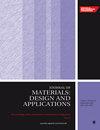Wire-arc-additively manufactured Bi metallic structure: Mechanical properties and microstructural characterization
IF 2.2
4区 材料科学
Q3 MATERIALS SCIENCE, MULTIDISCIPLINARY
Proceedings of the Institution of Mechanical Engineers, Part L: Journal of Materials: Design and Applications
Pub Date : 2024-09-09
DOI:10.1177/14644207241269590
引用次数: 0
Abstract
In this investigation, the fabrication and mechanical properties of Bi metallic structure walls produced using wire-arc-additive manufacturing (WAAM) technique, employing stainless steel (SS) 316L and 304 filler wires, are examined. The findings reveal that SS 304 exhibits superior mechanical attributes compared to SS 316L, notably showcasing impressive tensile strength and exceptional ductility. Bi metallic structure, meticulously constructed using both SS 316L and SS 304 filler wires, effectively replicates these distinctive mechanical properties, rendering it highly desirable for application prioritizing mechanical performance. The observed enhancement in strength is attributed to variations in microstructure resulting from a complex thermal history. Microstructural and crystallographic analyses of Bi metallic structure are conducted using optical microscopy (OM), scanning electron microscopy (SEM), energy dispersive spectroscopy (EDS), electron backscattered diffraction spectroscopy (EBSD), and X-ray diffraction spectroscopy (XRD). Additionally, tensile strength (TS) of Bi metallic structure surpasses that of WAAM SS 316L by 3.95%. This comprehensive research not only elucidates the intricate process of material selection in additive manufacturing but also underscores the significant potential of Bi metallic structure in meeting the stringent demands of engineering applications requiring exceptional mechanical properties.线弧加成型生物金属结构:机械性能和微结构表征
在这项研究中,采用不锈钢(SS)316L 和 304 填充线,利用线弧添加制造(WAAM)技术生产的 Bi 金属结构壁的制造和机械性能得到了检验。研究结果表明,与 SS 316L 相比,SS 304 具有更优越的机械属性,尤其是拉伸强度和延展性。使用 SS 316L 和 SS 304 填充丝精心制作的 Bi 金属结构有效地复制了这些独特的机械属性,使其在注重机械性能的应用中大放异彩。所观察到的强度提高归因于复杂的热历史导致的微观结构变化。使用光学显微镜(OM)、扫描电子显微镜(SEM)、能量色散光谱(EDS)、电子反向散射衍射光谱(EBSD)和 X 射线衍射光谱(XRD)对 Bi 金属结构进行了微观结构和晶体学分析。此外,Bi 金属结构的拉伸强度(TS)比 WAAM SS 316L 高出 3.95%。这项综合研究不仅阐明了增材制造中材料选择的复杂过程,还凸显了 Bi 金属结构在满足需要优异机械性能的工程应用的严格要求方面所具有的巨大潜力。
本文章由计算机程序翻译,如有差异,请以英文原文为准。
求助全文
约1分钟内获得全文
求助全文
来源期刊

CiteScore
4.70
自引率
8.30%
发文量
166
审稿时长
3 months
期刊介绍:
The Journal of Materials: Design and Applications covers the usage and design of materials for application in an engineering context. The materials covered include metals, ceramics, and composites, as well as engineering polymers.
"The Journal of Materials Design and Applications is dedicated to publishing papers of the highest quality, in a timely fashion, covering a variety of important areas in materials technology. The Journal''s publishers have a wealth of publishing expertise and ensure that authors are given exemplary service. Every attention is given to publishing the papers as quickly as possible. The Journal has an excellent international reputation, with a corresponding international Editorial Board from a large number of different materials areas and disciplines advising the Editor." Professor Bill Banks - University of Strathclyde, UK
This journal is a member of the Committee on Publication Ethics (COPE).
 求助内容:
求助内容: 应助结果提醒方式:
应助结果提醒方式:


